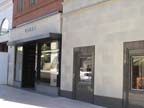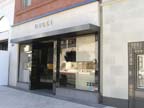
In designing the new Gucci Jewelry Boutique on North Rodeo Drive in Beverly Hills, CA, the high-end retailer modeled the materials palette after its premiere flagship store -- located only a few doors away. Panels of Indiana limestone were used to clad the exterior entry of the building, creating an elegant and inviting atmosphere for patrons.
“All of our stores need to be luxurious in addition to being viable retail entities,†said Lee Pearce, Worldwide Director of Store Planning & Architectural Services for the Gucci Group. “We gear our individual store sizes and the merchandise represented on a case by case scenario. Obviously Beverly Hills is one of the top five fashion/retail cities throughout the world, and the level of investment and finishes reflects this importance.â€
Indiana limestone was chosen for the facade of the new boutique -- which has 1,450 square feet of selling space -- to be consistent with the elaborate stonework of the nearby flagship store. “We wanted to provide our clientele with a true luxury goods shopping experience,†said Pearce. “The materials and the finishes [of the premiere flagship store] reflect the overall aesthetic of the house -- Italian craftsmanship and quality -- and many finishes are a nod to the historical Gucci stores of Europe.â€
According to Pearce, the limestone was originally selected for its composition. “The softness of the stone lent itself to be 'carved' in a time-honored manner known as 'chat sawn',†he said. “This technique is rarely used today, and set the facade apart from the competition as being hand-crafted and unique. The layout of individual stones and their respective geometry is by design; each stone that features the chat sawn finish was considered for how regular or irregular the chat sawn occurred, how it caught the sun and the play of shadow and light. Limestone is a beautiful material to work with, and the Indiana quarry featured the exact coloration desired by the design team.â€
In keeping with the quality and texture of the flagship store's limestone facade, the pieces used for the boutique were given a sandblasted finish. The panels, which were supplied and installed by Jerusalem Stone Collection of Sun Valley, CA, ranged in size from 3 feet, 6 1â„8 inches x 1 foot, 3â„4 inch to 6 feet, 3 3â„8 inches x 3 feet, 7 1â„8 inches x 1 1â„4 inches.
“I find it to be exciting that they used stone from the U.S. and not something from Italy,†said Abe Judah, president of Jerusalem Stone Collection. “When we got the job, we literally walked over to the other store and matched the type of finish. We provided control samples [to Gucci representatives], and they approved them. When we received the material, we made sure that it matched [the samples].â€
According to Judah, the pieces were mechanically fastened to the wall. “Because it was high-end, I got involved,†he said. “I rarely do installations.â€
The installation was completed in two days, with Jerusalem Stone Collection carefully working with the restrictions of Beverly Hills ordinances, Judah explained. “We couldn't have more than three workers on the job,†he said. “Working in Beverly Hills is very delicate. There are only certain hours that you can work, and you have to put up a barricade. We had two people on scaffolding and one helper.†The new Gucci Jewelry Boutique opened its doors for business in December 2003.

End box
Gucci Jewelry BoutiqueBeverly Hills, CA
Owner: Gucci Group
Designer: Studio Sofield, New York, NY
Stone Supplier / Installer: Jerusalem Stone Collection, Sun Valley, CA
